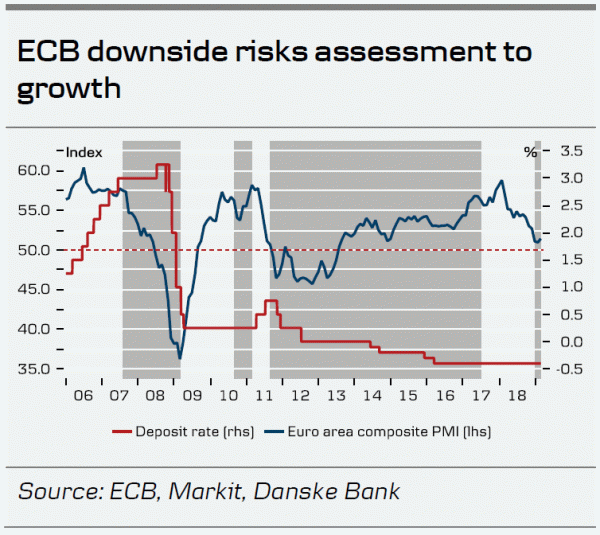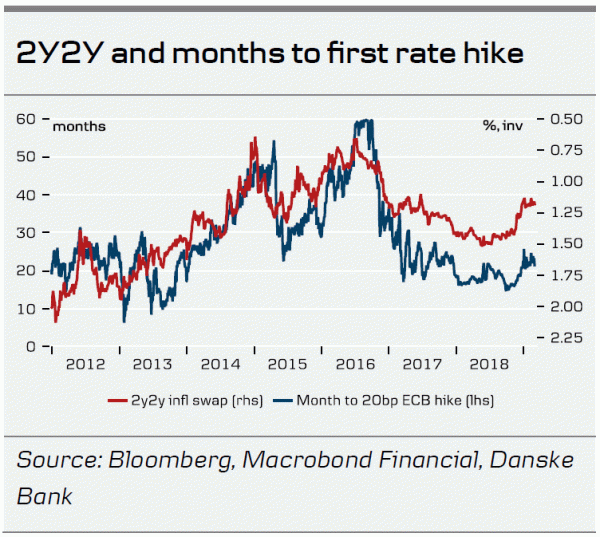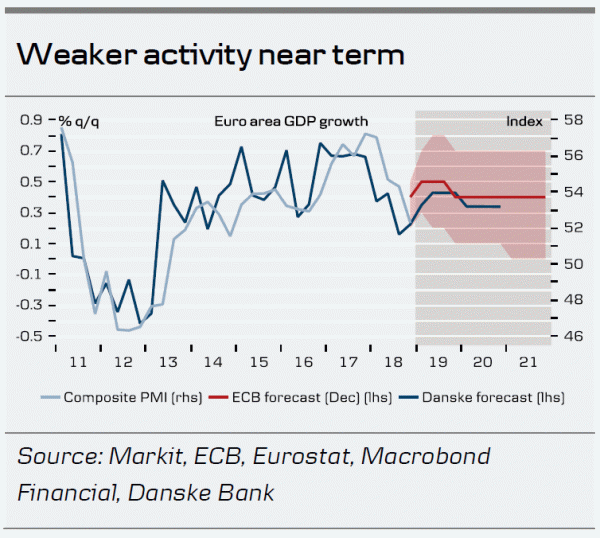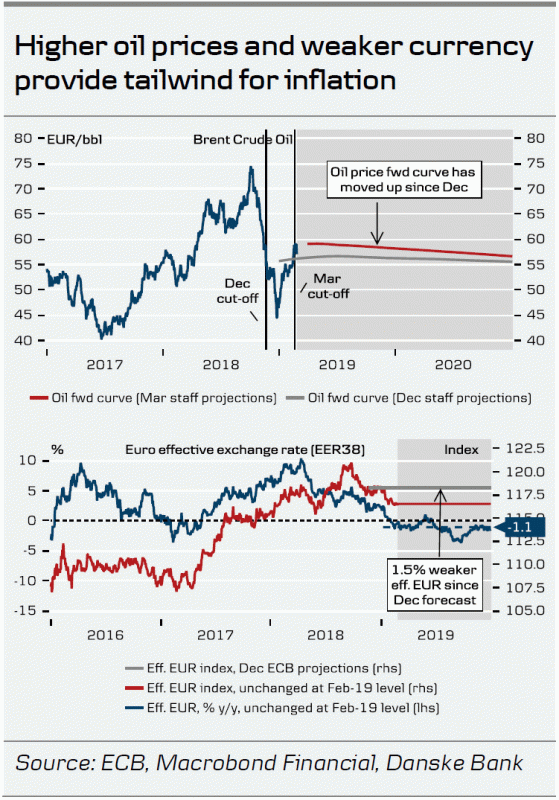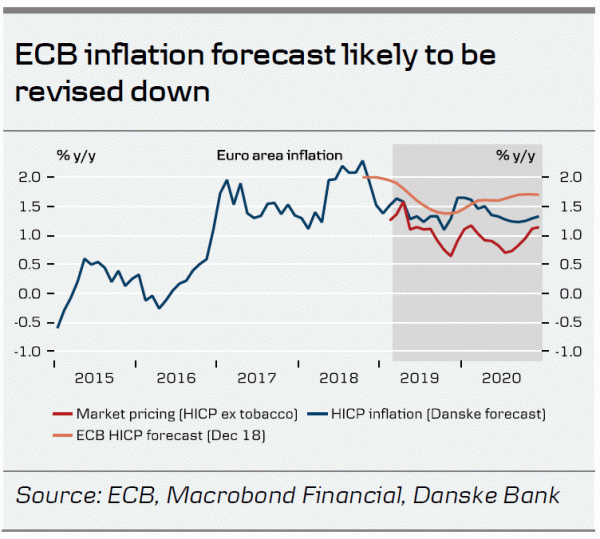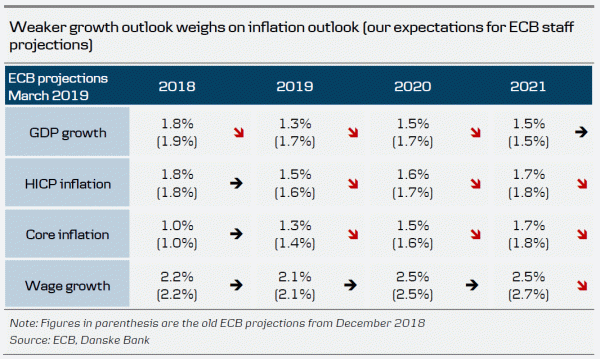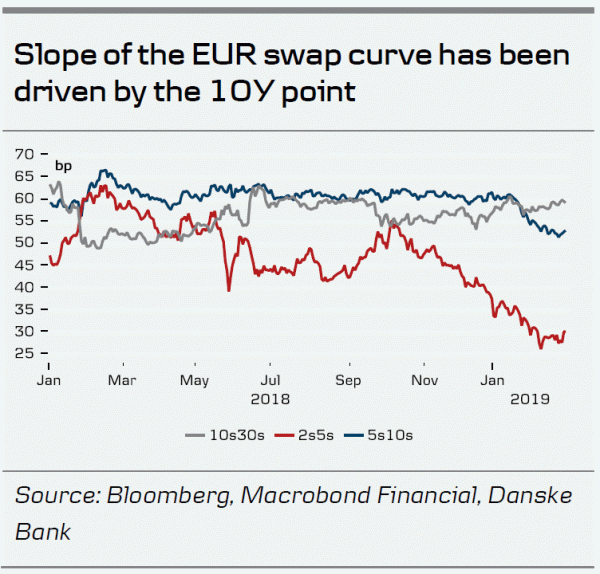- We expect the ECB to acknowledge the risks to the euro area economy at next week’s meeting but we do not expect to see any policy decisions yet. We do not expect a liquidity operation announcement either.
- The staff projections will be instrumental to the ECB narrative but as several ECB governing council members have emphasised the importance of assessing the impact on the medium-term inflation outlook, we expect the ECB to look through short-term weakness in the data at this stage and note that it remains ready to stimulate the economy if needed.
- While in the near term the growth outlook remains fragile, we do not expect the ECB meeting to change the overall narrative or market sentiment. However, watch for a potential volatile and sharp intraday market reaction as market expectations for the meeting are more dovish than ours.
Waiting for further data
At the recent Governing Council meeting in January, the ECB changed its growth balance of risks to be skewed on the downside. At that stage, it was clear that the January meeting was an ‘assessment meeting’ and not a ‘policy meeting’. However, we do not expect the March meeting to be a policy meeting either. Incoming data since the latest Governing Council meeting has been on the weak side, with some stabilisation noted in some data points. At the same time, the January ECB minutes showed that domestic drivers were broadly intact, as they attributed the main risks to external/political drivers. As a result, we expect the ECB await further data before taking a decision in terms of policy implications. The ECB meeting is set to bring new staff projections. We expect a mechanical downward revision of growth projections, which importantly would not lead to a change in policies at this stage. Over the past month, Governing Council members, particularly Philip Lane and Peter Praet, have re-emphasised that it is the medium-term outlook that is important for conducting monetary policy.
TLTRO – Targeted Longer-Term Refinancing Operations
Over previous weeks, the potential of a new liquidity operation (TLTRO) has attracted significant market attention. We discussed why TLTRO was no longer our base case for March in ECB Research – TLTRO – no longer our base case, 8 February, as we did not see a strong monetary policy case already (see also the arguments in the table overleaf). While we do not find compelling evidence for announcing a new liquidity round next week, we highlight that we may see such operations later this year if it is warranted by the monetary policy case. The maturity of the TLTRO starting in June 2020 has drawn attention as ‘two’, ‘some’ and ‘several’ Governing Council members commented on it at the October, December and January meetings, respectively. The ECB minutes from the January meeting indicated that the liquidity situation is being discussed but no ‘decisions in this respect should not be taken too hastily’.
Importantly, a potential liquidity operation would be announced to target a specific problem and the modalities would be highly dependent on the problem identified.
Therefore, we stress that a liquidity operation could come later this year. Further to this, we could see a liquidity operation as part of a three-legged package: rate hike, liquidity operation and strong forward guidance. However, given that we believe the current forward guidance on rates will remain at present levels ‘at least through the summer of 2019’, such a package would require a change in forward guidance at an earlier stage.
Despite low market-based inflation pricing we still expect a rate hike this year
Inflation market pricing, measured by inflation swaps, hast stabilised somewhat in recent weeks on the 2Y2Y horizon after a marked decline around the turn of the year, while only in recent days have we seen some stabilisation in the 5Y5Y area. The repricing is causing concern for the ECB. Amid this, the inflation market has been strongly correlated with rate hike market pricing (measured by the number of months to the first rate hike) and has yet to show an uptrend. In our view, this should come when data turns better. Similarly, we find the results of longer term inflation expectations in the recent survey of professional forecasters results as equally concerning. Expectations have declined to 1.82% (some 6pp above the historical low).
Although we continue to expect a downside risk assessment from the ECB next week, we do not change our ECB rate hike call from December 2019. The softer data at the start of the year has already been warranted, albeit the numbers have been slightly worse than we expected. Our main argument for expecting a rate hike by the end of the year is due to our expectation of wage growth translating into underlying inflation towards summer.
We consider the ECB pricing is still on the dovish side, amid the weaker-than-expected incoming data in January. Currently, only 6bp is priced in for a December 2019 rate hike, which compares with our base case of a 20bp hike at that stage.
Lower growth near term but narrative unchanged
As mentioned above; at the January meeting, the ECB changed its growth risk assessment to the downside. Further, President Mario Draghi hinted that the Governing Council would reassess the implications of the euro area slowdown at a later stage, potentially as soon as March. Hence, the updated economic projections will be instrumental in framing the ECB’s policy narrative. Since January, both hard and soft data have on balance surprised on the downside. Euro area growth remained subdued in Q4 18 at 0.2% (well below the ECB’s baseline) and PMIs point to continued headwinds in the manufacturing sector despite signs of strengthening domestic demand and rebounding service sector activity. Furthermore, ECB has increasingly become concerned about the negative impact of persistent political uncertainties on business confidence and investments.
We expect to see a marked downward revision of the growth forecasts for 2019 and 2020 to 1.3% and 1.5%, respectively (see table below). However, more important in terms of monetary policy communication will be whether the growth slowdown is seen as permanent or of a temporary nature. Judging from recent ECB speakers, we believe in the latter and expect the new profile still to show some slight acceleration in quarterly growth rates in H2 19 on the back of stronger domestic demand.
Therefore, we expect the ECB to acknowledge that the euro area economy is likely to grow below potential in the near term. However, with the economy regaining some momentum in H2 19 and growth seen close to potential over the medium term, we think the ECB will hold on to its strategy of gradual policy normalisation and not change the narrative unless the near-term data releases warrant a change in communication.
Softer inflation dynamics
A weaker growth profile over the medium term would also have implications for the inflation outlook and to use ECB Chief Economist Peter Praet’s words: ‘three-quarters of below-potential growth is certainly not good news’. We expect the ECB to hold on to its narrative that ongoing labour market improvements and rising wages will eventually push up underlying inflation pressures. This said, the (so far) missing transmission from wages to consumer prices is becoming an increasing worry for the ECB, as the January minutes revealed. On the back of the weaker growth outlook, we could see the ECB adopting somewhat softer language regarding the speed and magnitude of wage pass-through to consumer prices. Last week, ECB Vice-President Luis De Guindos has already given a glimpse of this, when referring to the ECB’s confidence that underlying inflation pressure ‘will pick up within a few months or quarters’.
Technical assumptions of higher oil prices and a weaker effective euro should on balance lift the ECB’s inflation profile. However, we expect this to be countered by the weaker growth outlook and slower wage pass-through, resulting in a lower profile for core inflation. From tradition, we still look for the forecasts to show HICP inflation ‘close but below 2%’ over the medium term.
FX: waiting for a shift in rate guidance – but too early still
In short, the main thing the FX market is waiting for from the ECB is for it to revisit its forward guidance on rates and, as this is unlikely to be changed this month, we think it remains too early for the ECB to drive significant EUR strength. If we are right that no liquidity injection will be announced in March, the knee-jerk reaction could be some limited EUR support though, as this would at first sight be seen as a hawkish signal. It is worth noting that even if the ECB goes for TLTRO – now or later in the year – to the extent that this paves the way for an earlier move on the deposit rate, everything else being equal, it could be a EUR positive signal. We reiterate that the sheer shift that is evolving with the ECB looking to exit ’emergency measures’ (and get back to zero) and the Fed becoming more patient (i.e. hesitant to hike) a firm floor has been established for EUR/USD. We see the cross in a range around 1.15 near term and stress that a shift in ECB rate guidance brewing mid-year, provided the global cycle stabilises, is a key trigger for a shift into the 1.20s.
Fixed income
Given our baseline of an unchanged narrative from the ECB, the curve is likely to stay flat or even flatten more, as the 10Y segment still offers the best carry relative to the risk. Hence, we believe the curve is still too steep. There has been some speculation about the ECB not wanting to continue to ‘feed’ expectations for a dovish monetary policy, which would lead to a sharp reversal in rates. However, we believe the ECB is very conscious of the market reaction (and potential increase in volatility), which would be an unwarranted response for the ECB.
Therefore, we expect the ‘hunt for yield’ to continue with more spread compression. Recently, the very strong ‘hunt for yield’ has materialised in strong demand in the peripheral government bond markets, as well as in EU credit markets and EU covered bond markets. The syndicated deals from the start of the year have seen a solid performance and there has been a significant oversubscription to the deals. Hence, the fear that, for example, Italy would not be able to sell bonds after the ECB had ended QE has not materialised. The star performer this year has been Portugal, where spreads to core EU and the other peripheral countries have tightened significantly.
Furthermore, the political uncertainty from the upcoming Spanish election has had no limited on the Spanish government bonds, which have performed against core EU and one of our top trades for 2019 – long 5Y Spain versus 5Y France – has almost reached its target for a profit of 25bp.
The market has clearly ‘priced out’ rate hikes from the ECB as shown by the flattening of the 2Y-5Y curve, while the 5Y-10Y has lagged the movement in the 2-5Y slope. The German curve has flattened markedly in recent months.




